Using AI to Predict AQI
Grade 12
Presentation
Problem
Problem:
How well can an AI model predict AQI values? And how can we use this to our advantage in combating the fight against poor air quality around the world?
An answer to this problem or topic can be the means of life or death for many people around the world. As AI gains more knowledge and innovation continues. The abilities of AI can be endless and not limited to computer skills or personal use. AI can expand to become a leading tool used for AQI. A number one indicator for poor air quality is AQI, poor air quality is high AQI, and this along with neural networks and machine learning models can help us identify how we should approach these problems to make sure we keep everyone safe and healthy. AI can help us get predictions faster and more efficiently to create a response quicker like lowering emissions or other plans for long-term air quality combat. While short-term air quality predictions from AI can help in wildfire combat, especially the model's 7-day predictions, if AQI gets high over 7 days we can decide to ensure more effort is put into putting off these effects. AI is useful in the right settings, AQI prediction can help us plan, and decide how to make the air we breathe cleaner saving millions of lives.
Hypothesis:
Predictions produced by AI using AQI values from previous historical data can depict results that accurately predict future AQI values which in turn can enhance knowledge and help us better prepare for poor air quality situations around the world.
Method
My Method includes many steps and research aspects.
- Firstly I used AQI data from the United States Environmental Protection Agency (EPA), for the model as the United States is one of the main users of AQI and the AI model provided by ScienceBuddies is designed for AQI use.
- Secondly, I put all of the data the EPA provided into one spreadsheet with all AQI overall values as well as carbon monoxide, ozone, particulate matter (2.5 and 10) and nitrogen dioxide AQI values.
- Lastly, I would run the spreadsheet through the AI model provided by ScienceBuddies, and analyze the Mean Absolute Error, Mean Squared Error and R² value to assess the model's accuracy with predictions.
- These are the amendments I did to make sure the model could run with the New Delhi data I found:
- Amended 4B and 4C, as the data table headings were different and other data provided needed to be removed due to not being in AQI values
- Amended Code Block 4D, as the data found did not include individual pollutant AQI data to fill, so needed to add an AQI code block to make sure no actual AQI data points were missing.
- Amended Code Block 4E, as data found did not include individual pollutant AQI data to preprocess, so it was not needed.
- These are the amendments I did to make sure the model could run with the New Delhi data I found:
- Then, I would along with my research make an accurate conclusion if AI can accurately predict AQI values.
Research
What is Air Quality?
Air quality is how pure our air is. According to NASA scientist Kristina Pistone, “Air quality is a measure of how much stuff is in the air”. Air quality is measured by the Air Quality Index The air quality Index is determined by how many pollutants there are in the air, and how concentrated in a given area it is. An area with good air quality would not have many solid pollutants that are less concentrated, while somewhere with poor air quality would have lots of pollutants concentrated greatly within a given area. Air quality is basically how clean the air is, and how many pollutants or particles affect the air.
What is Air Pollution?
Air pollution is the actual particles and contaminants that pollute the air we breathe, air pollution is directly related to air quality. The World Health Organization defines air pollution as the contamination of indoor or outdoor environments by physical, chemical, or biological agents that defines or modifies the characteristics of an environment. Outdoor air pollution's most common causes are vehicle emissions, household combustion devices (like heating, etc), industrial facilities, forest fires, agricultural processes, and forest fires. Indoor air pollution is mostly caused by smoke, radon, biological organisms (like mould, etc), chemicals, household products, and more. These causes release particles into the air, diminishing air quality, which can lead to a variety of impacts on human health, the environment, etc.
Some common outdoor air pollutants are:
- Particulate Matter (PM), is a blanket term for pollutants that are injurious to health and safety. Some examples of particulate matter are sulfates, nitrates, ammonia, sodium chloride, black carbon, dust, and water. Particulate matter is separated by size with PM2.5 and PM10 being the most common ones that impact human health.
- Large particulate matter includes anything from pollen, sea sprays, dust from roadways, agriculture, erosion, and more. These particles have a diameter of 2.5 to 10 micrometers
- Small particulate matter includes anything with a diameter of 2.5 micrometres or less, including the combustion of fuels in vehicles, power facilities, and more. Most commonly, origins of particulate matter are based on location, but include traffic, power plants, mines and more.
- Carbon monoxide (CO), is a colourless, odourless and tasteless gas that is toxic, it is mainly produced through the incomplete combustion of carbonaceous (relating to or composed of carbon) fuels like wood, gasoline, charcoal or natural gas. The most major source of carbon dioxide in ambient air is from motor vehicles.
- Ozone (O3), ozone at ground level is prominent in photochemical smog, which is formed through the reactions of gases with sunlight. The major sources of ozone are from motor vehicles and industrial settings.
- Nitrogen dioxide (NO2), is a reddish-brown gas that is typically released from the burning of fuels, mostly from motor vehicles or industrial sectors. In an ambient setting, nitrogen dioxide comes from the combustion of fuels at high temperatures like heating processes (furnaces, etc). Nitrogen dioxide is known as an ozone precursor.
- Sulfur dioxide (SO2), is a colourless gas that has an odor, it is also produced from the burning of fossil fuels like coal and oils. It is also produced from the smelting of ores that have sulfur as a compound.
Air pollution is known to have detrimental effects on human health, which is why air quality should be monitored closely to ensure the well-being of all is maintained.
What is AQI?
The Air Quality Index (AQI) is primarily used in the USA, it is a range of values from 0-500 that determine how bad or good the outdoor air quality is. There are six categories that contain values that pertain to s specific rating of the air quality. The higher the AQI the more air pollution, and the more health concerns there is relating to breathing in particles and pollutants.
When the AQI is under 100, it is generally safe, with the index having “Good” (air pollution poses no risk) from 0-50, and “Moderate” (air pollution poses no risk, but might be a risk to those who are sensitive) from 51-100, when the AQI is over 100, then there is generally a concern with 101-150 being “Unhealthy for sensitive groups” (air pollution poses risk to members of sensitive groups that have health conditions), 151-200 being “Unhealthy” (some members of the general public will be vulnerable to air pollution, and sensitive groups might experience more impacts), 201-300 being “Very Unhealthy” (air pollution is a risk to everyone) and 301-500 being “Hazardous” (warning, everyone is most likely going to be significantly impacted). AQI numbers are derived from
How is AQI Measured?
- Air quality is measured mostly from satellite-derived monitors that produce a reading on how bad the air is in an area. Some common satellites like the Joint Polar Satellite System (JPSS), and GOES-R satellites all detect and measure pollutants from wildfires to industrial pollutants and more.
What is AQHI?
The Air Quality Health Index is designed specifically for the health-related risks for the public to interpret and decide upon themselves. We use this measure in Canada. AQHI is a number on a scale of 1-10, where the higher the number the more significant the risk is. Associated with an AQHI value is a message that suggests what you should do and the risk that the air quality pertains.
A value of 1-3 pertains to a “low risk”, and you can enjoy normal activities since the air quality is ideal, a value of 4-6 means that conditions ate “moderate risk”, and that people who are typically at risk should reduce strenuous activities if experiencing symptoms, while the general public doesn’t need to make changes to activities or plans, a value of 7-10 means “high risk”, and that people at risk should reduce or reschedule their activities and exposure outside, while the general public should also reduce if they are experiencing symptoms, a value of 10 or more means that everyone should reduce or reschedule activities outdoors as the air quality is poor, while people at risk should avoid the outdoors at all times. The Government of Canada labels the at-risk population as people with heart or breathing conditions like asthma, and that you should always listen to your doctor's discretion. Typically during wildfire season, we see values of 7-10+ proving that pollutants can impact everyday life.
How is AQHI calculated:
- The values are calculated from a cumulative of all of the common pollutants that impact human health and life like ozone, particulate matter, nitrogen dioxide, and more. Nationally, it is collected through data observed in the major cities, just like AQI.
AQI versus AQHI:
- AQHI focuses on reporting the risks to the public about air quality, while AQI measures individual air pollutants and the risks they pose. AQHI is a cumulation of all pollutants and gives a more health-related approach to how to manage air pollution and air quality. While AQI is the single worst pollutant in air quality and gives more future-based readings. They both have their strengths and weaknesses and are generally accepted throughout the world.
What is AI?
Artificial intelligence (AI), is a type of technology that helps in problem-solving, analysis, and more. According to IBM, AI is the technology that enables computers and machines to simulate learning, problem-solving, comprehension and decision-making, and creativity. AI is easily adaptable to human ways, like language, and they can learn from information. This is important in predicting, and problem solving. AI has many benefits including supporting problems, the capability of deep learning through neural networks, and language processing. AI does not fit one description, it is very flexible with what it can do for us, and what it can help us with.
What is an AI Model?
An AI model is a program that has been trained on a specific set of data, an AI model can recognize certain patterns or make certain decisions on its own. An AI model has its algorithm for the specific data that it was trained for, this ensures accuracy and helps it achieve relevant tasks. An AI model is mostly notable for what it does by itself, without a human present. An Ai model can accurately predict, analyze, and make decisions. It is important to differentiate a model which is the output of an algorithm's data, and that an algorithm is the procedures and actual code that gets the model to output accurately.
What is Machine Learning?
Machine learning is how computers and machines emulate humans strongly. Machine learning is how AI learns, performs tasks, and improves through more data exposure. There are three main parts on how a machine learns according to UC Berkeley:
- Decision process, the ways algorithms predict and classify input data. An algorithm can decide patterns based on your data.
- The error function can evaluate the prediction of the model and can help make a comparison to assess the accuracy of the model
- Optimization Process, a process that helps retain models’ accuracy through optimization and evaluation, until a good amount of accuracy is met.
Machine learning gains insight through learning, and can gain autonomy and decision-making skills. Deep learning is further evolution to machine learning, through neural networks.
Neural networks:
- Is a machine learning program that makes decisions that mimic the human brain. Like neurons and actual neural paths. A network consists of nodes, an input layer, other hidden layers, and finally an output layer. They are all interconnected much like regular neurons. Thresholds have to be met for data to be continuously pushed through the network for an output like how neurons work with the brain to respond to an environment. They rely on training data to improve accuracy over time and are powerful for making predictions and such in computer science.
Training AI models
- AI training is a process that is dependent on the quality of the input given to the model. AI training is both the algorithms selected and the data imputed, AI training is basically feeding the model data to better itself at predicting and analyzing the data. Large amounts of data training is needed to get good results. Data is the most crucial step in model training, it is all dependent on the data and how good it is.
What is RNN?
Recurrent neural networks (RNN) Is a type of neural network focused on sequential data or time series, that creates a machine learning model that can make sequential predictions on sequential inputs. RNN requires other timely manner data points as this is how it makes its predictions, it is good to note that obviously, RNN cannot predict future events that throw data off, all of its output is based on previous data points. RNN continuously remembers data points when it processes a current one, this allows for both a timely approach in predicting a value. RNNs are usually restricted in predicting values in the very far future, as accuracy declines due to data fluctuations, but it is very good for near-future applications.
What is LSTM?
Long Short Term Memory (LSTM) is an enhanced version of an RNN, that helps capture long-term dependencies, making them good for language learning, or time-sensitive predictions like AQI. LSTM produces a memory cell instead of a single hidden state with RNN, a memory cell can continuously store information aiding in predicting or addressing long-term learning for the model. LSTM can selectively retain or forget information as it learns and gathers it. This data is also updated continuously. LSTM can be used in a variety of settings, like language, speech, time series, anomaly detection, video analysis, and many more. LSTM is amazing for predicting based on a time basis, this is why it is used in the AI model used to predict AQI.
What are the effects on Air Quality, the environment human health:
Health:
- The effects of air quality on human health are detrimental. Air pollution primarily is exposed to us through our airways. When we breathe air that has poor air quality all of the particles like particulate matter, carbon monoxide, ozone, and all others get into our system directly. The breathing in of these particles leads to our airways degrading through inflammation, stress, and other conditions that are injurious to our health. Therefore these particles directly affect our cells throughout our body, impacting our organs and therefore leading to diseases. Long-term exposure to poor air quality can lead to horrid complications in our health. These effects could include stroke, heart disease, and cancer. While short-term exposure can lead to reduced lung function, infections in the lungs, asthma and much more.
- Children, older people and pregnant women are among those who are susceptible to poor air quality and any exposure to it. In pregnant women, air pollution can lead to developmental problems in their baby like low birth weight and more.
- Both ambient and indoor air pollution can lead to poor health, it is all dependent on the quantities and types of matter in the air when you breathe it.
- According to the European Environment Agency, the most significant air pollution is PM2.5, which drives the rates of diseases and mortality in 2021. PM2.5 is so fine that it can travel much deeper into our tissues, organs and more in our body leading to more damage to our health and wellbeing.
- Air pollution directly affects our health for the worse, it is always dependent on how concentrated a certain particle is, these factors all are considered when determining how impactful air pollution is on human health.
Environment:
- Air pollution has been proven to have negative effects on the environment. From impacting acidity in lakes to degrading soil composition, air pollution is directly impactful on the environment. Ecosystems and our environment can be affected by air pollutants.
- Just like humans, wildlife can be impacted through their respiratory systems as well. Air pollution can lead to respiratory problems, neurological problems, and skin irritation.
- Plants are also impacted by air pollution, ozone in particular is known to cause harm in plants. Ozone damages parts of the plant like the stomata, which helps the plant respire, it is also known that crops have taken a toll as well.
- Physically, pollutants cause acid rain, when sulfur and nitrogen are in the air, acid rain forms. Acid rain can further damage vegetation, increase the acidity of soil and eaters, and can kill us as a species. Pollution also reduces sunlight, which can lead to a reduction in photosynthesis and the production of oxygen. Pollution also retains heat more in our atmosphere, leading to impacts in weather, and the climate.
- Famously, in the late 20th century, a hole in our ozone layer was formed through the amount of pollutants created on Earth. Chlorofluorocarbons (CFCs) were used in refrigerants and sprays, all common household pollutants. The amount of CFC released into our atmosphere created a hole. The chlorine atoms in the CFCs destroy ozone, which is very crucial for life on this planet. The ozone protects us from UV radiation, which for humans can lead to things like cancer and mutations, while for our environment it can restrict plant growth and the development of other species.
- The impact air pollution has on the environment is very dramatic, much of which is harmful to us and all of the other species we share our plant with.
Where is the air quality bad?
Air quality impacts everyone who lives on this earth. But it is more prominent in some areas than others. Poor air quality is common in Africa and Asia. Air pollution is also more concentrated in urban areas than rin ural areas. PM2.5 is fairly prominent in south, east and southeast Asia, Africa and some Latin American countries. Pollution affects poorer, third-world cities and regions more than richer prosperous nations.
Air quality and wildfires:
Wildfires are an increasing risk to the environment and humanity. Wildfires can have a devastating effect on ecosystems, human health and air quality. Wildfires occur due to hot, dry conditions and when combined with droughts, heatwaves, high winds or negligence in high-risk areas (like leaving a campfire on in the forest). Wildfire primarily impacts air quality through smoke, a by-product of the combustion of the actual wildfire. Smoke releases a lot of particles into the air, such as PM2.5, nitrogen dioxide, ozone carbons and many more. These pollutants are toxic and can be a serious problem to human health and the environment. Wildfires also impact greenhouse gas emissions due to the amount of carbon dioxide released by the burning. In Canada, wildfires are the main cause of poor air quality, in many areas across the country. The impact smoke has on air quality is very serious, as PM2.5 can increase leading to more exposure to pollutants that are dangerous to us as a society.
Data
*Please note that I could not include Canadian data as all of it was AQHI, the model I used from my resource is designed for AQI values ONLY. Please see the above research for more information about the difference between AQI and AQHI.
Areas:
- For my model’s predictions, I chose Los Angeles, New Delhi and New York. Los Angeles was picked due to recent wildfires, and high population. I will be inputting all pollutant-measured AQI data, found directly from the EPA.New Delhi was picked due to being in a region with high levels of PM2.5, inferring that AI could be the difference between life and death. I will be inputting PM2.5 AQI data found from an external source. New York was picked due to notorious poor air quality, which comes from a stem of resources. But notably from vehicle emissions and industrial, combined with high living density New York’s air quality is bad. AI can help New York combat a decades-long problem with accurate predictions.
Los Angeles:
- In Los Angeles, air pollution has posed a significant challenge over time. Los Angeles is notorious for having the United States worst air quality at points. With an increasing population, and booming industry Los Angeles is plagued with bad air quality. Los Angeles has been tight on supporting better air quality, through incentives such as emissions control. Los Angeles primarily gets poor air quality from air toxins, emissions from various automobiles like diesel or regular passenger cars, and traffic density. LA has a very bad traffic problem that leads to more particles in the air. In 2025 wildfires raged the Los Angeles area and was devastated by damage and especially wildfire smoke. Smoke is a direct cause of poor air quality, accounting for a significant amount of PM2.5 pollutants as well as others which again can be detrimental to health. Air quality in the Los Angeles area is a main concern, and If AI can accurately predict AQI for pollutants it can help in wildfire preparedness, the impact on the environment, and the impact on human health.
New Delhi:
- Air quality is a major concern in India and surrounding areas, Indian cities suffer from sometimes the worst air pollution in the world. India does not have strict industrial regulations and environmental laws, also given the rapidly expanding industrialization air quality suffers in India. New Delhi was ranked the most polluted capital city in 2023, according to IQAir. The government of New Delhi has been trying to combat this advising against the use of coal and firewood and to cut vehicle emissions. Sadly, people have been grieving the effects of this poor air quality, with 81% of families knowing at least one person suffering from the poor air quality. New Delhi has abnormal rates of PM2.5 and smog from a variety of sources including power plants, vehicles, industry, cooking and more. Sadly, 2 million people die early due to air quality according to the Clean Air Fund, additionally more and more people are suffering from respiratory and cardiovascular diseases. As air quality is among the worst in the world in New Delhi, a call for more monitoring and such is need and if AI can accurately predict future AQI quantities, it can drastically improve India’s approach to combat this and save millions of lives.
New York:
- New York is also notorious for its poor air quality, with dense fog and toxins in the air threatening the lives of many. Due to New York’s very dense urban environment, this has been a concern for many years and has been improved. This poor air quality primarily comes from vehicle and industrial emissions. Weather, atmospheric conditions and human activities also contribute to air emissions. All major pollutants but significantly nitrogen dioxide from vehicles, sulfur dioxide from heating and PM2.5 from a variety of sources plague the city. New York has made strives to reduce its pollution, reducing the amount of PM2.5 by 23% during COVID-19 and it continues to stay low as the years go on. New York continuously monitors its pollution situations, with continuous monitoring, and health advice to citizens. But with AI predictions, New York can continue to make efforts to combat poor air quality, and make the necessary steps to make sure people are healthy and fit.
Prediction:
Basics:
- Mean Absolute Error (MAE), the model I am using uses MAE to determine the accuracy of the model's prediction. It advises the alteration between the original values imputed into the model and the model's predicted values. A lower MAE means that the model’s prediction is more accurate. A MAE of 0 would mean it's completely accurate while a MAE of 10 means the prediction might differ by plus or minus 10.
- Mean Squared Error (MSE), the models I am using also use MSE to assess the accuracy of the model. MSE is used to measure the squared average difference between the input data values and the predicted values by the model, it allows us to analyze the accuracy of the model's prediction. Again the lower the MSE the better the prediction.
- R-squared value (R²) or coefficient of determination, is a statistical value that assesses how well the regression model predicts the values based on the data given. An R² of 1 means that the model predicted the AQi values perfectly, an R² of 0 means that the model did poorly on predicting the AQI levels and if it’s in between 0.50, it means that the model could only predict around 50% of the variation in AQI data for the future. The better a model is at making predictions the closer to 1 the R² value will be.
Data
Los Angeles:
|
Days |
MAE |
MSE |
R² |
|
7 |
16.572866439819336 |
525.6592407226562 |
0.71 |
|
28 |
17.13582992553711 |
604.5259399414062 |
0.68 |
|
365 |
15.085165977478027 |
424.5594482421875 |
0.69 |
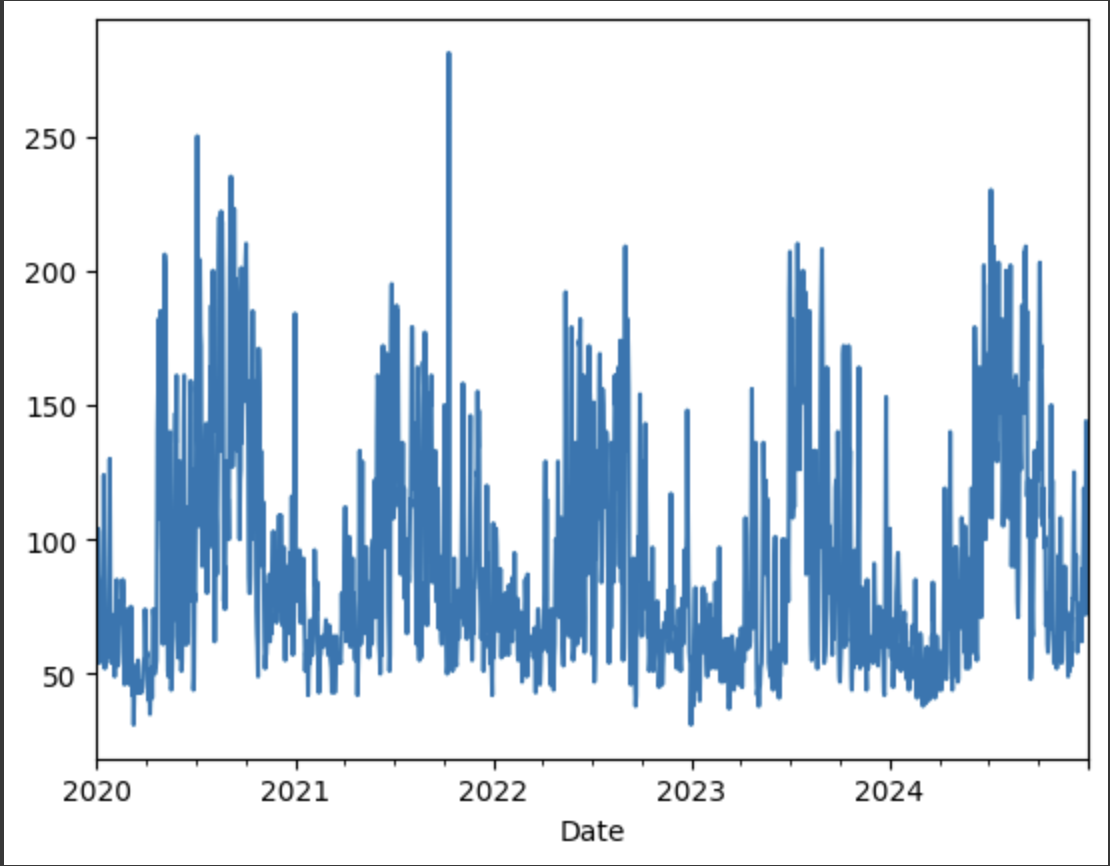
Los Angeles AQI Data from 2020-2024
7 day:


AI Prediction VS Actual Values

R² value
28 days:
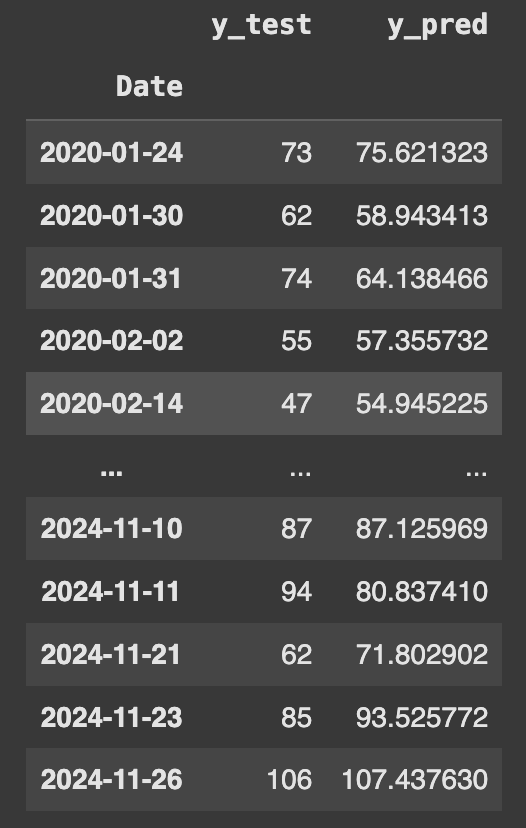

AI Prediction VS Actual Values

R² value
365 days:
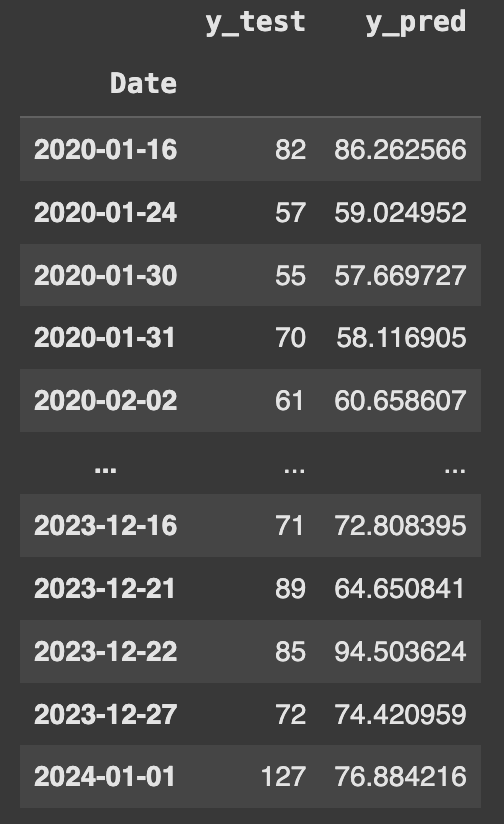
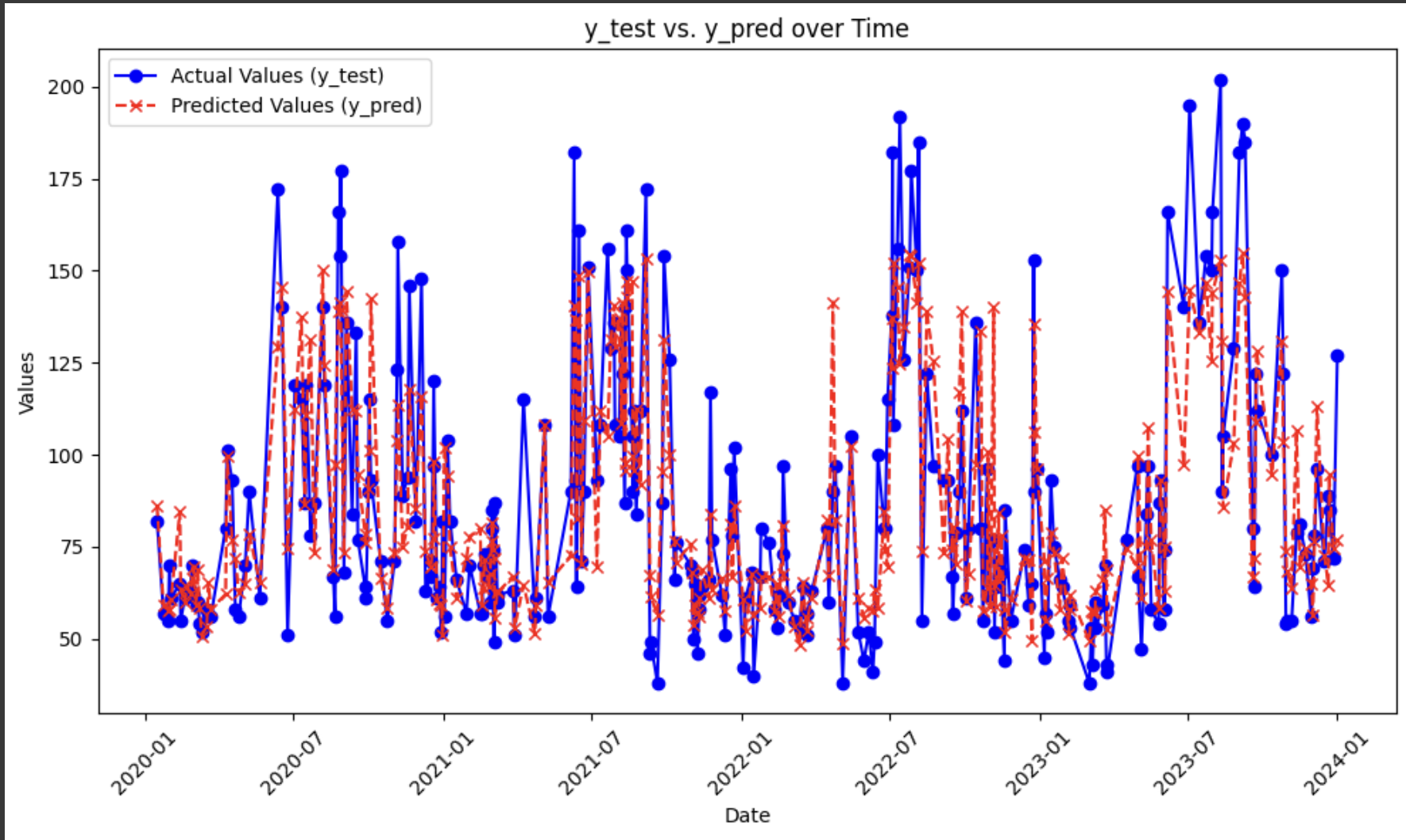
AI Prediction VS Actual Values
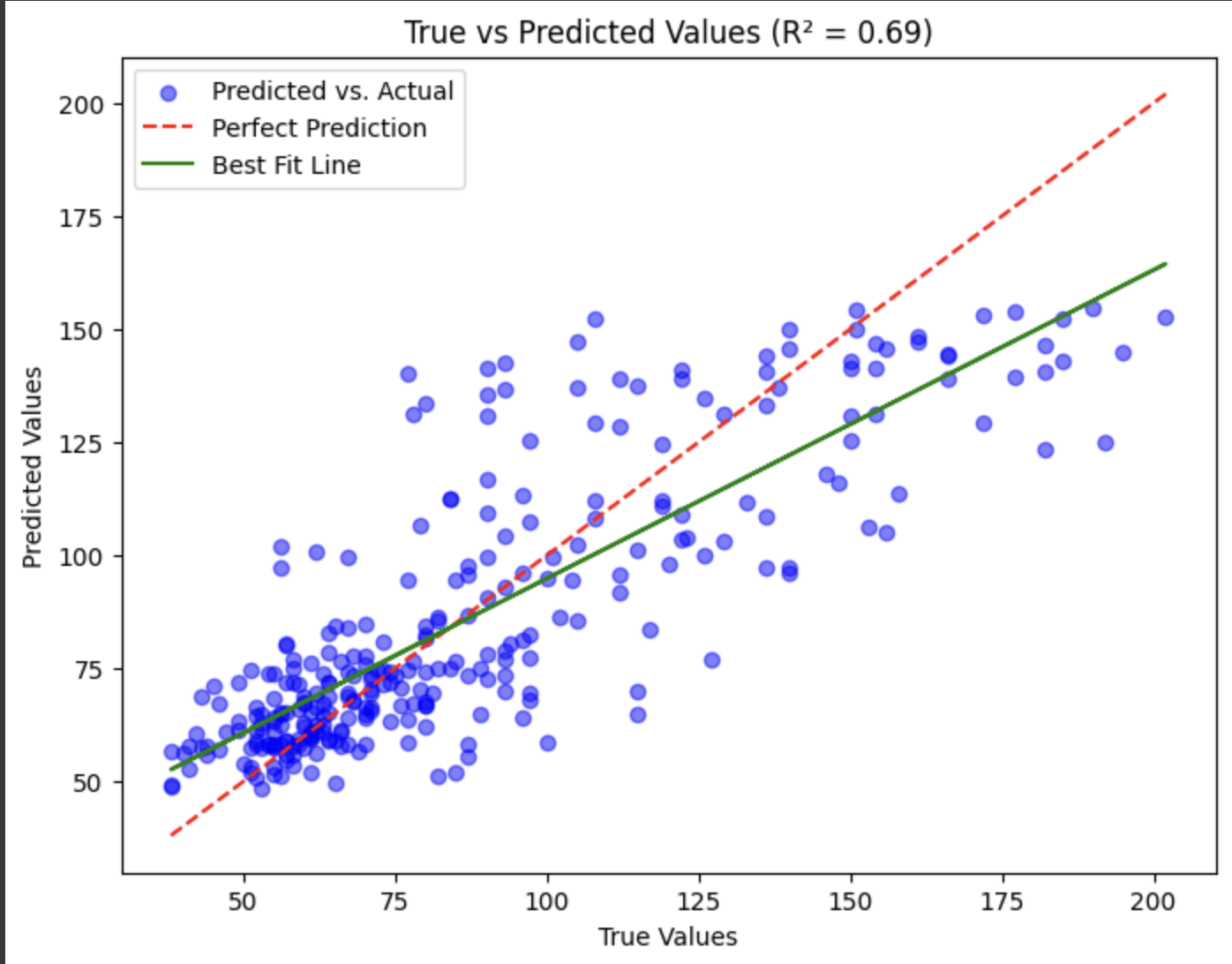
R² value
New York:
|
Days |
MAE |
MSE |
R² |
|
7 |
12.351764678955078 |
305.3481140136719 |
0.30 |
|
28 |
13.044343948364258 |
455.7431945800781 |
0.34 |
|
365 |
13.022153854370117 |
380.1777038574219 |
0.35 |
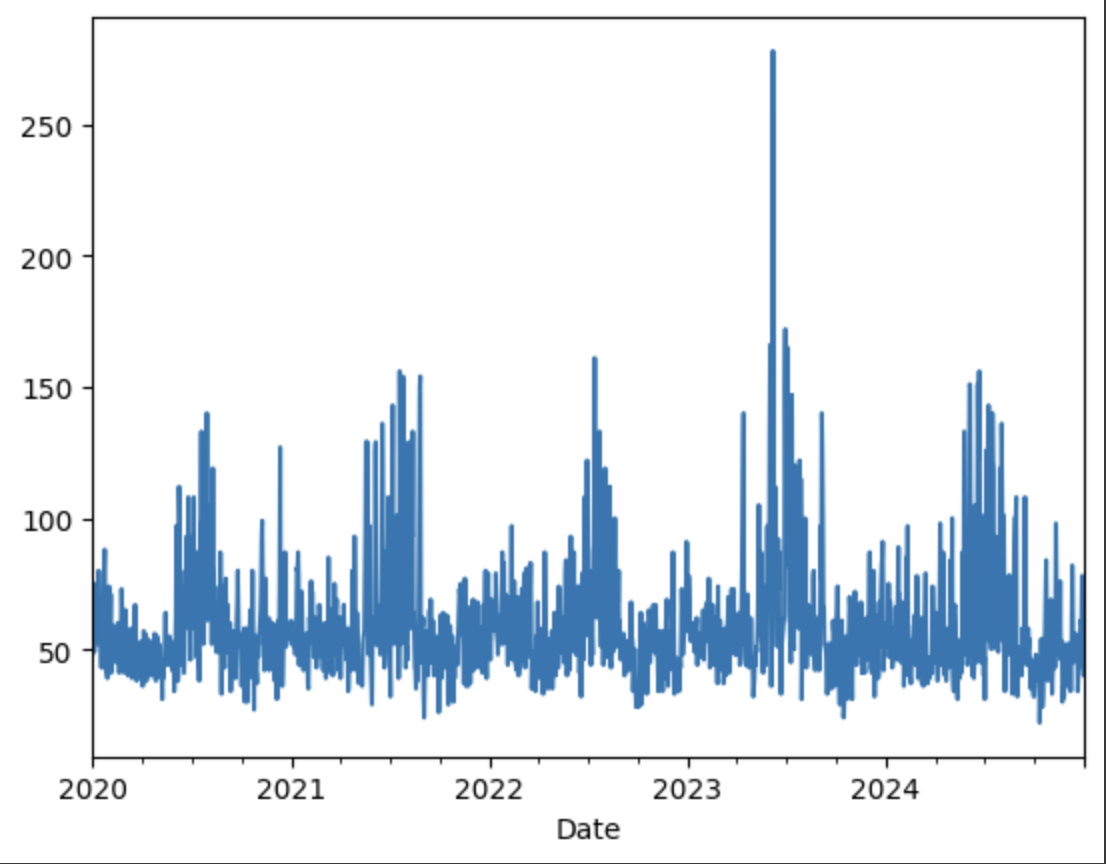
New York AQI Data from 2020-2024
7 days:
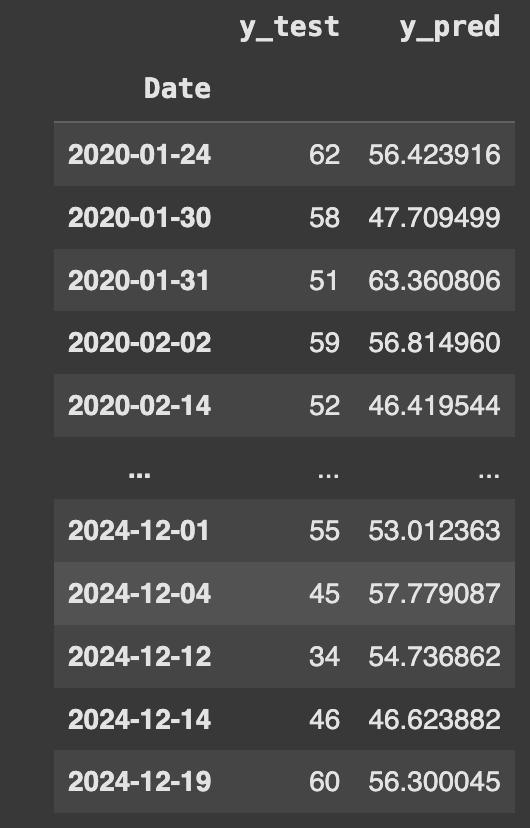
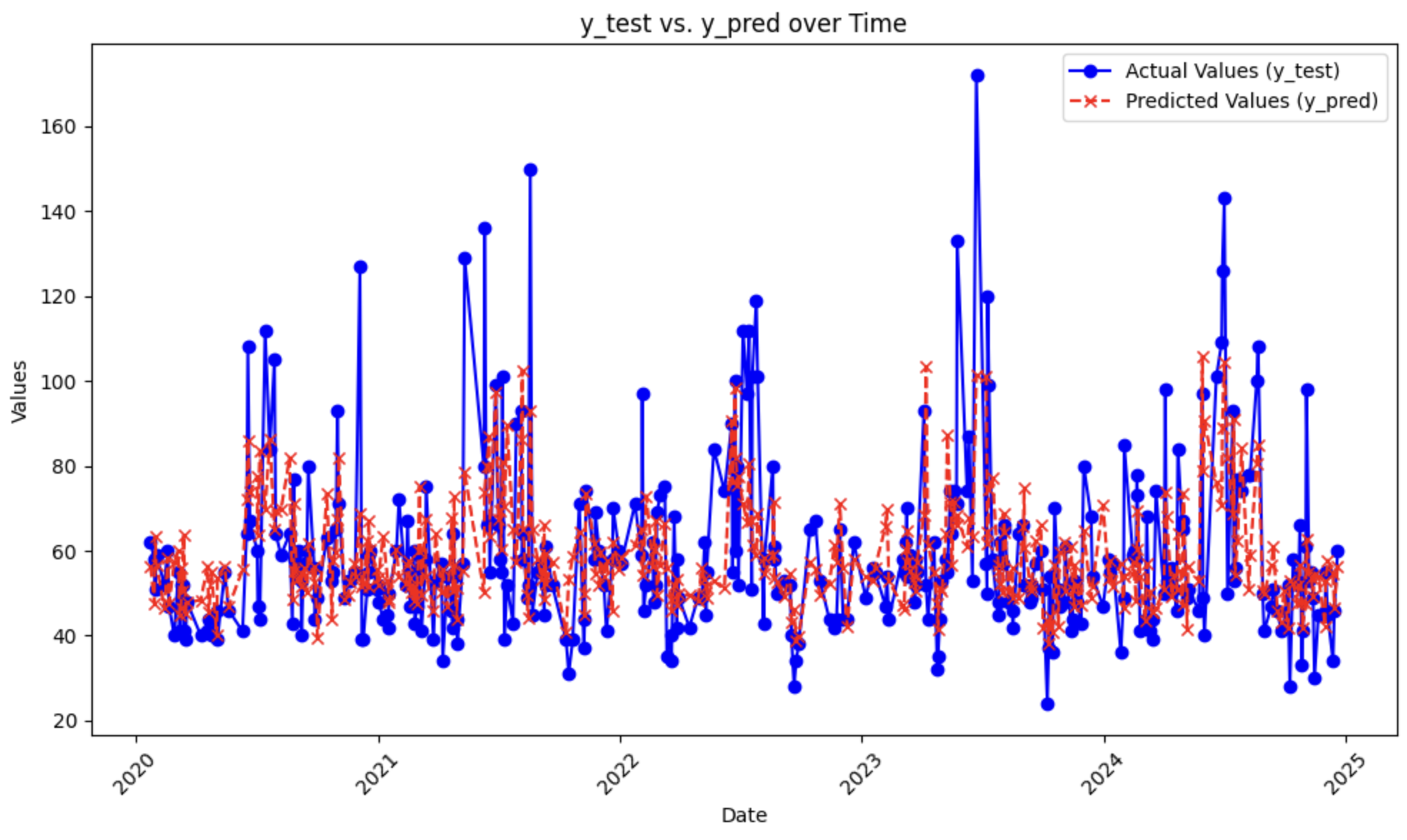
AI Prediction VS Actual Values
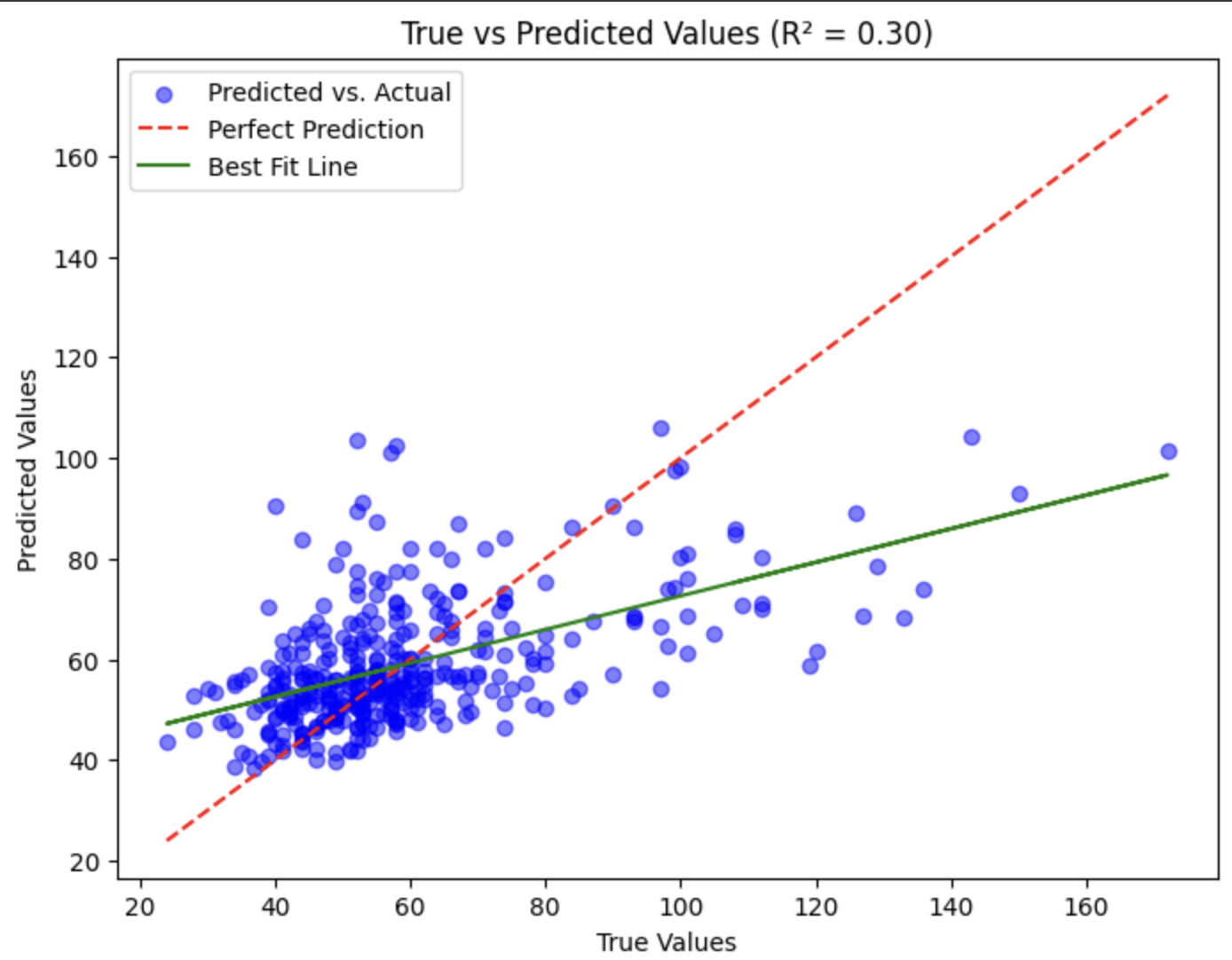
R² value
28 days:
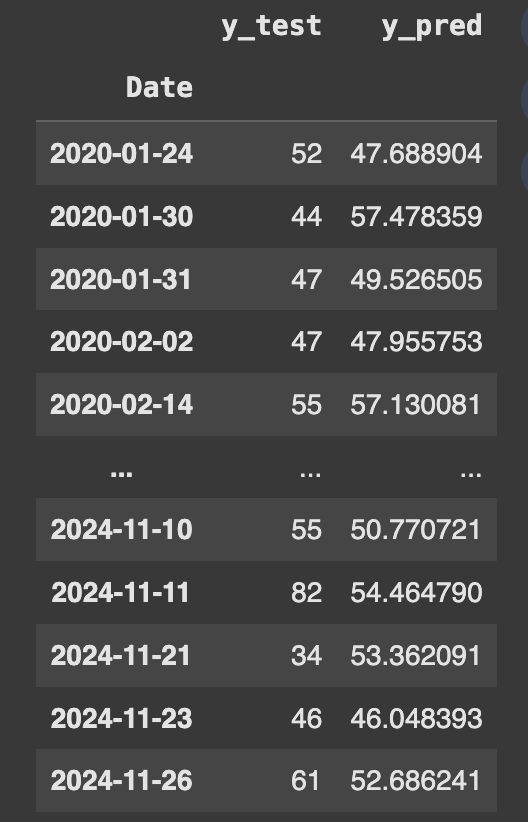

AI Prediction VS Actual Values
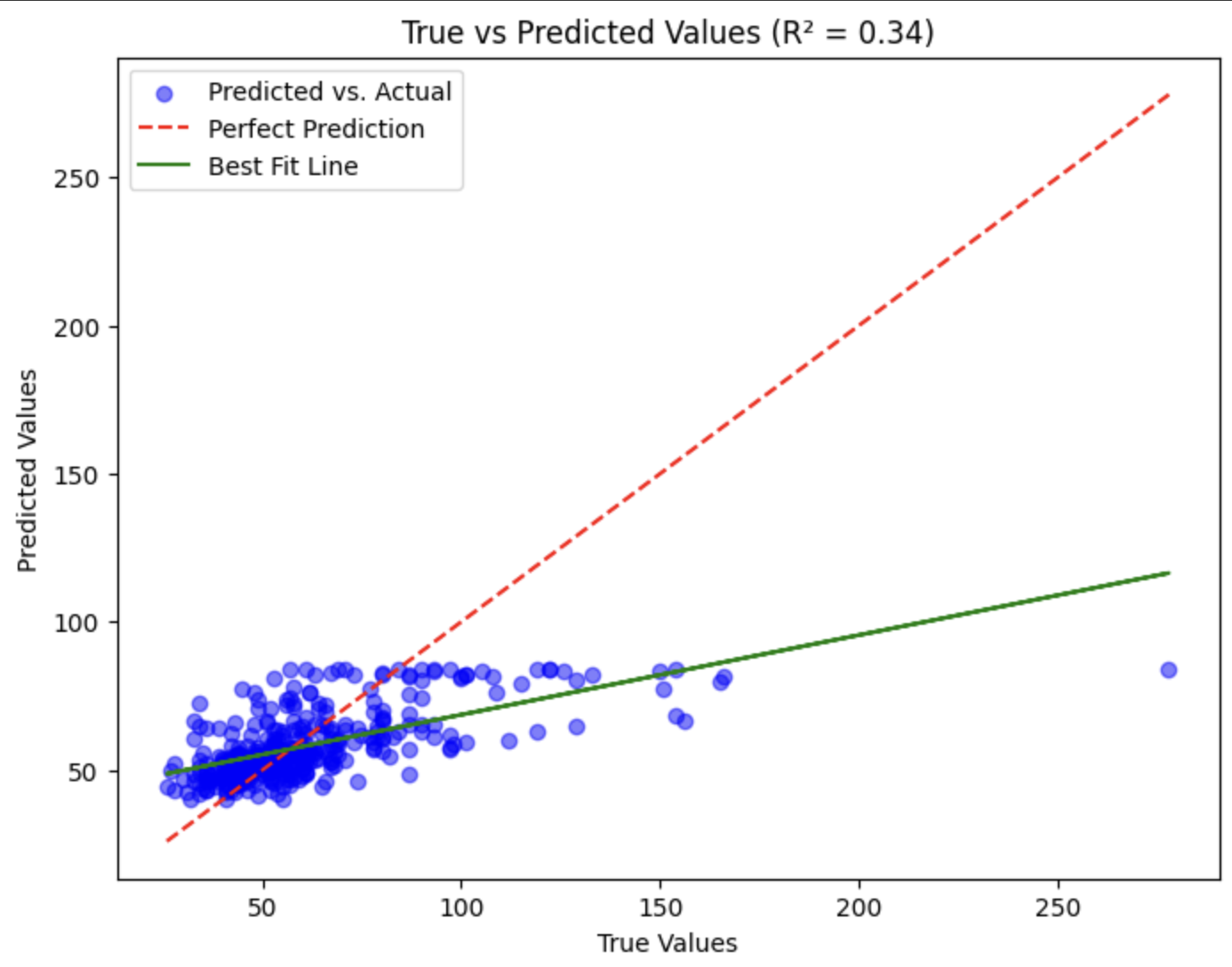
R² value
365 days:

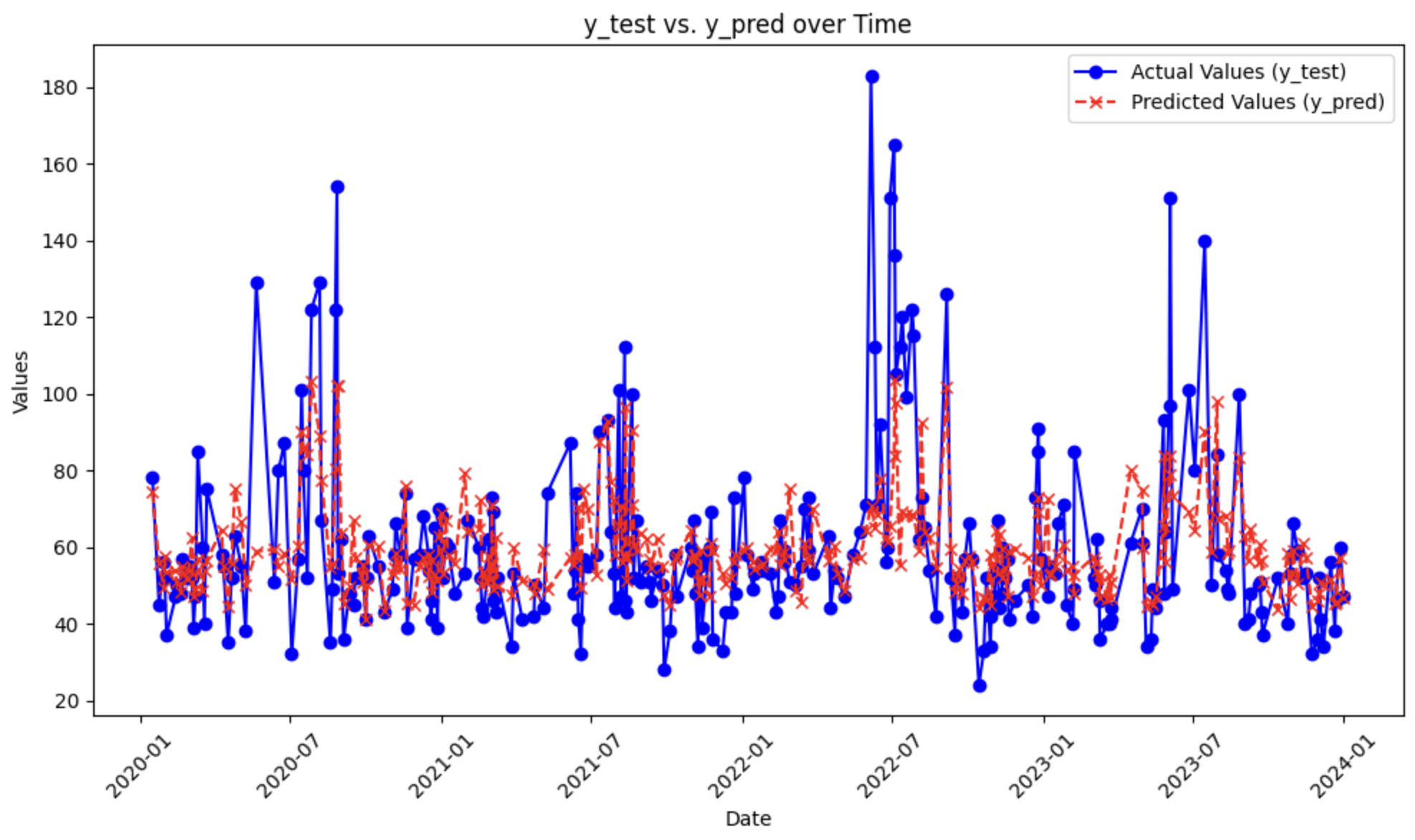
AI Prediction VS Actual Values
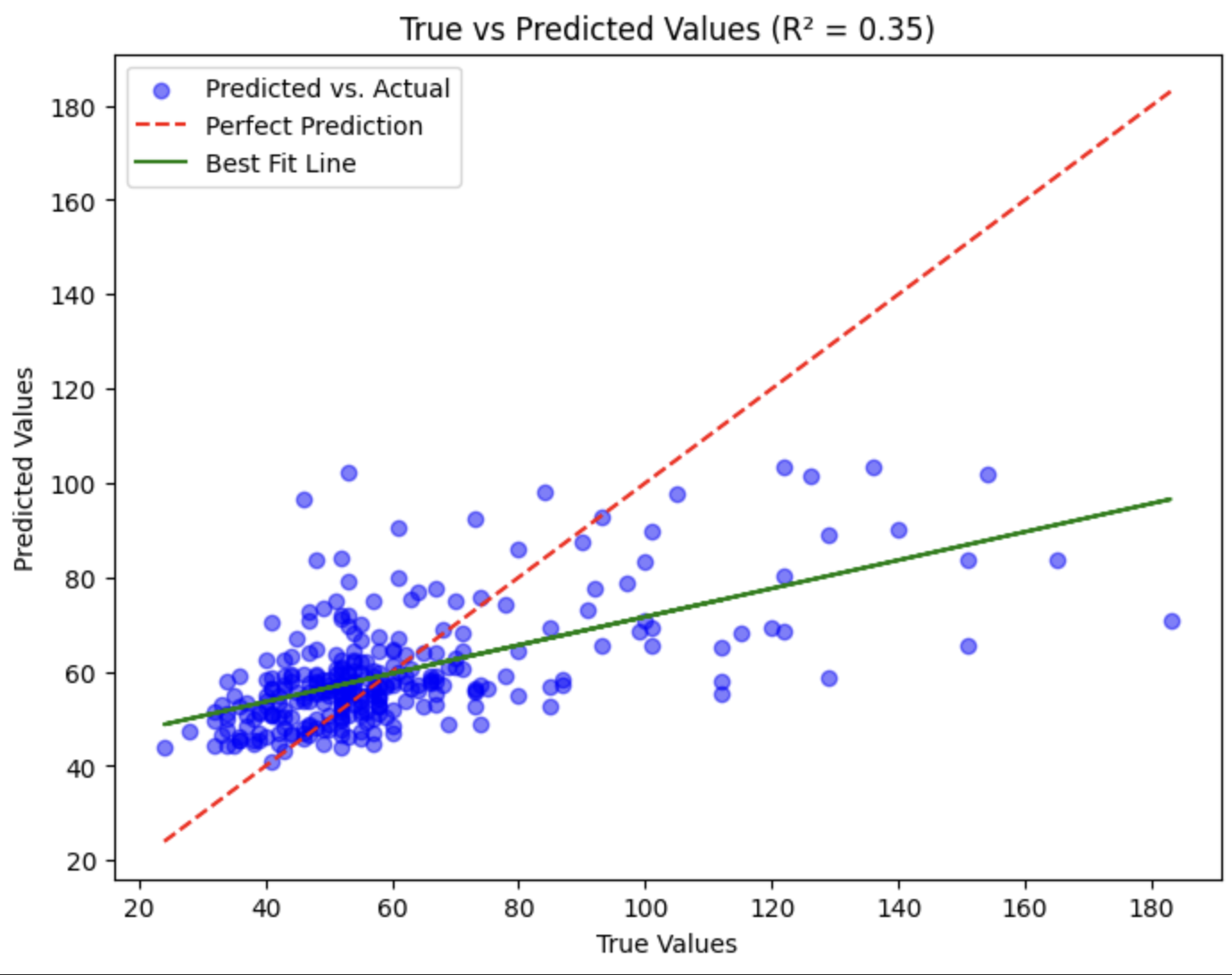
R² value
New Delhi:
|
Days |
MAE |
MSE |
R² |
|
7 |
37.33435821533203 |
2697.043212890625 |
0.81 |
|
28 |
41.82926559448242 |
3275.412109375 |
0.76 |
|
365 |
39.886558532714844 |
2962.348876953125 |
0.84 |
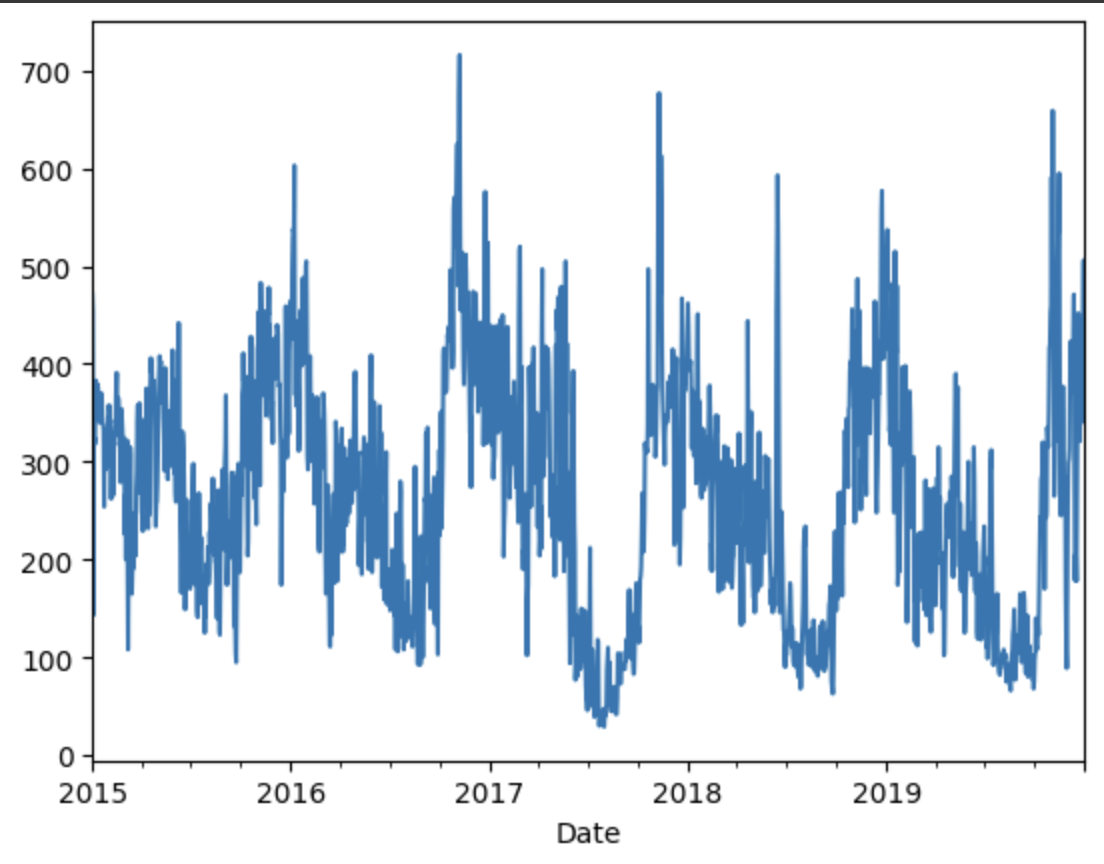
New Delhi AQI Data from 2015-2019
7 days:
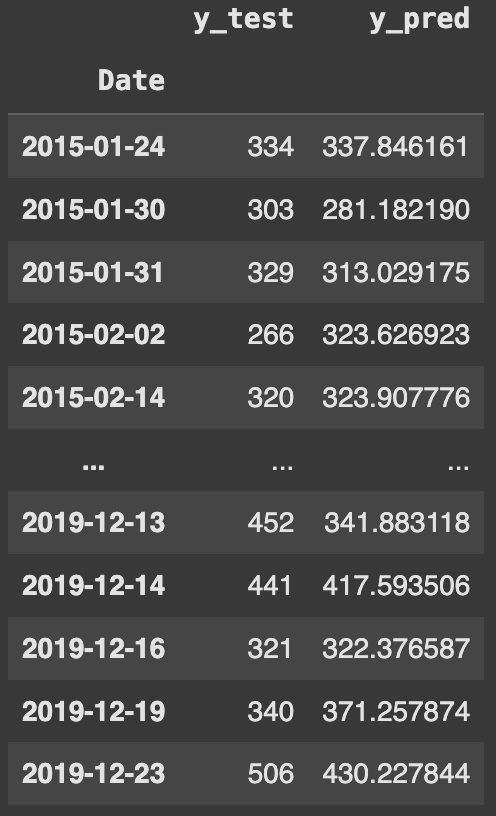
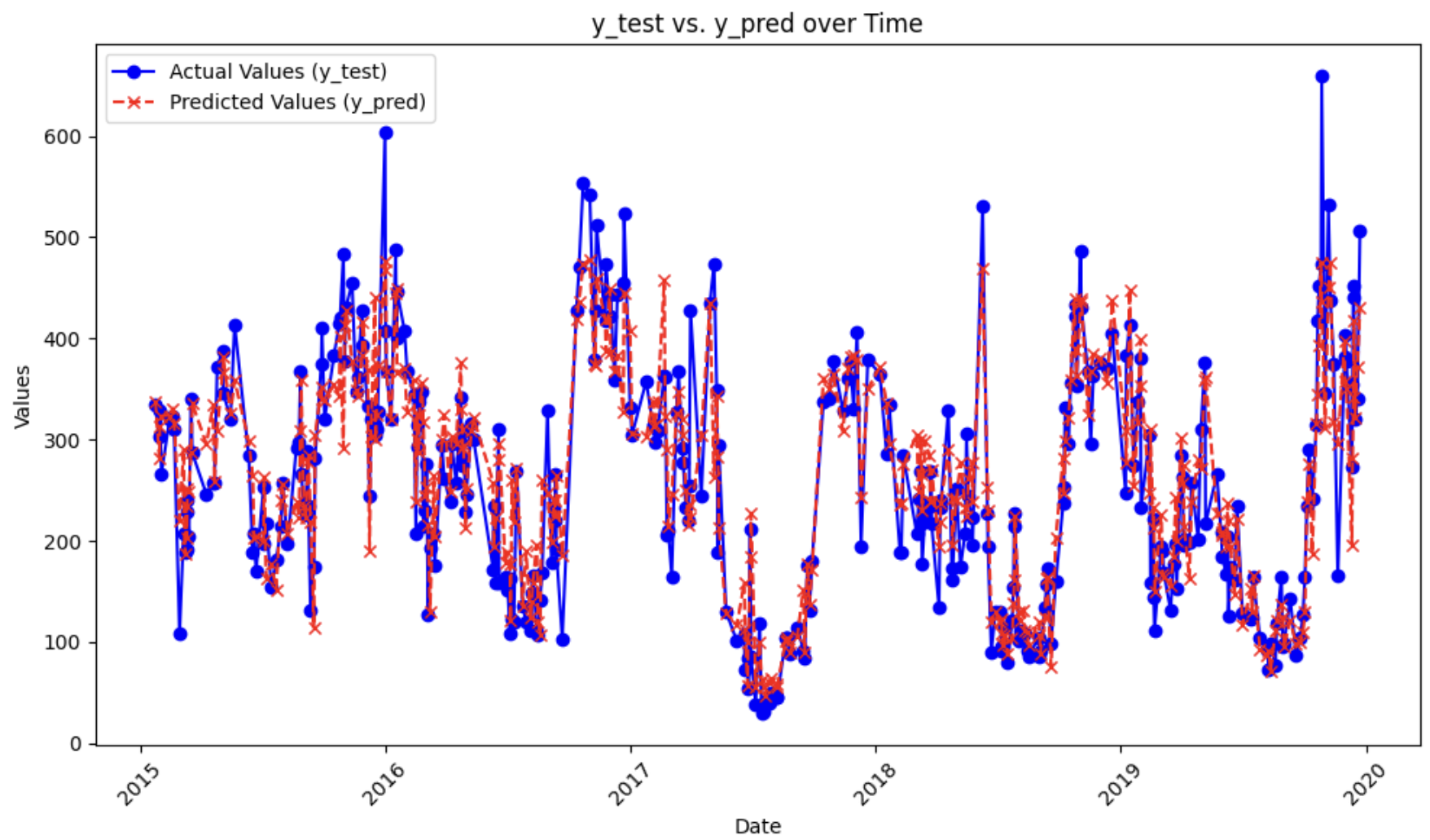
AI Prediction VS Actual Values
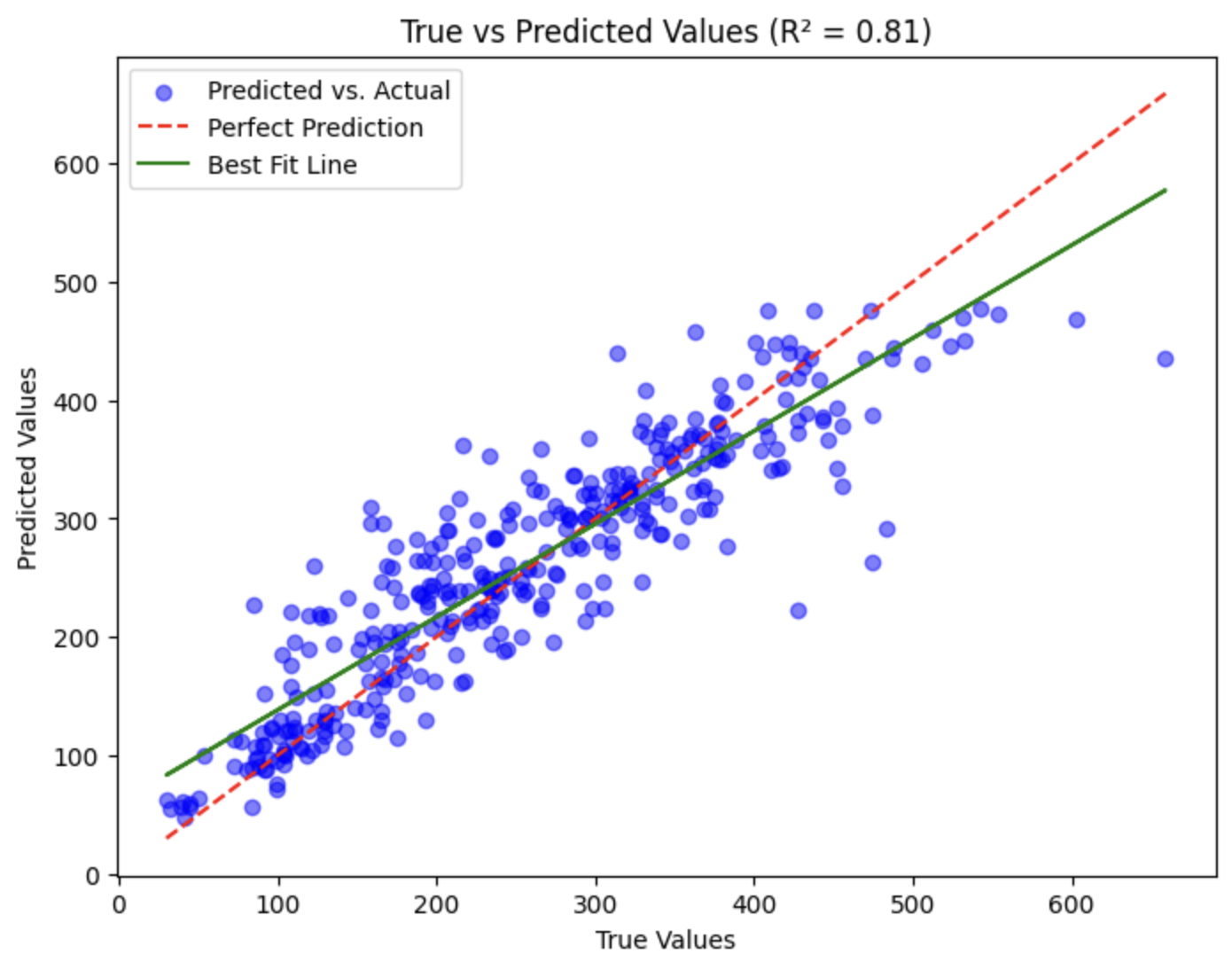
R² value
28 days:

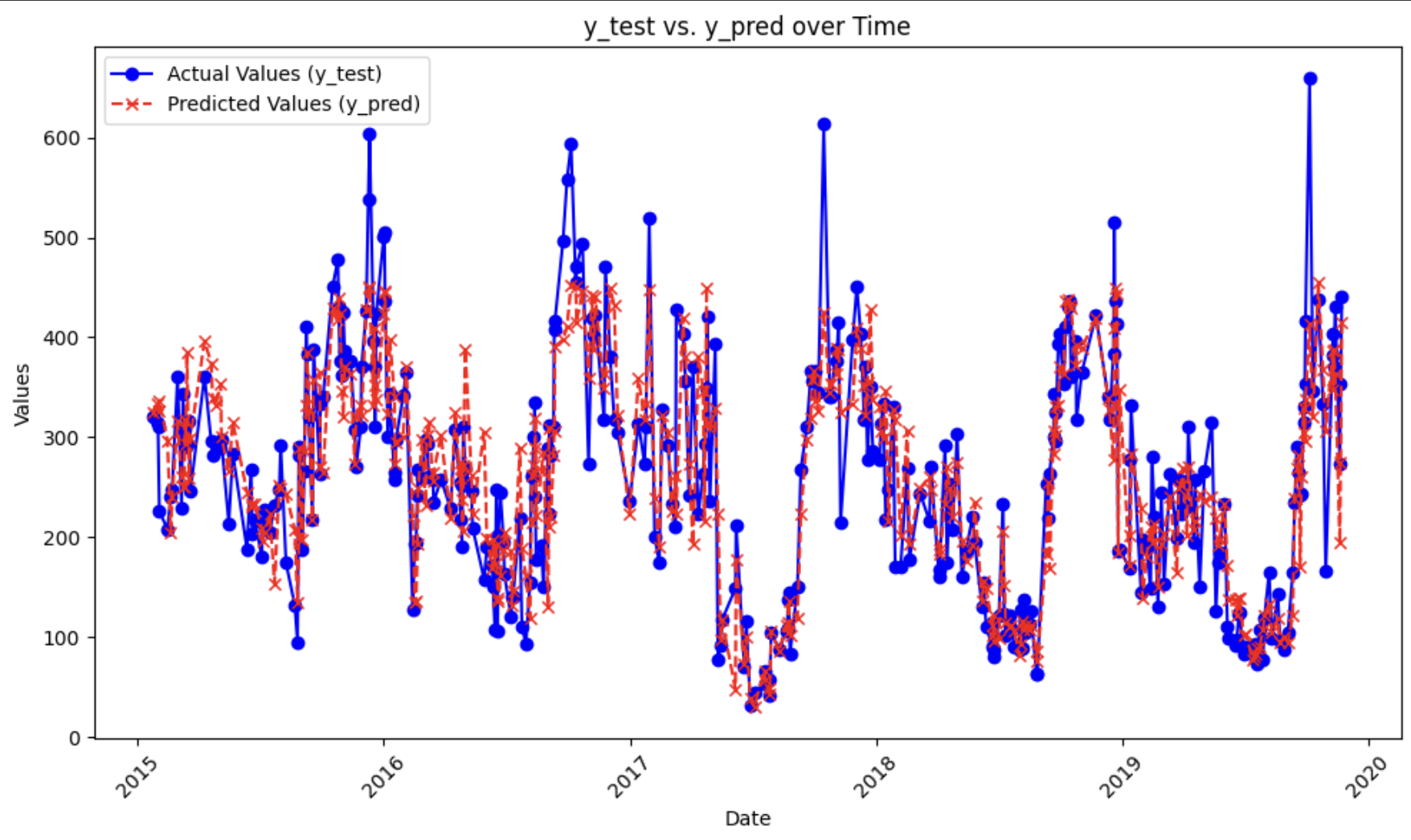
AI Prediction VS Actual Values
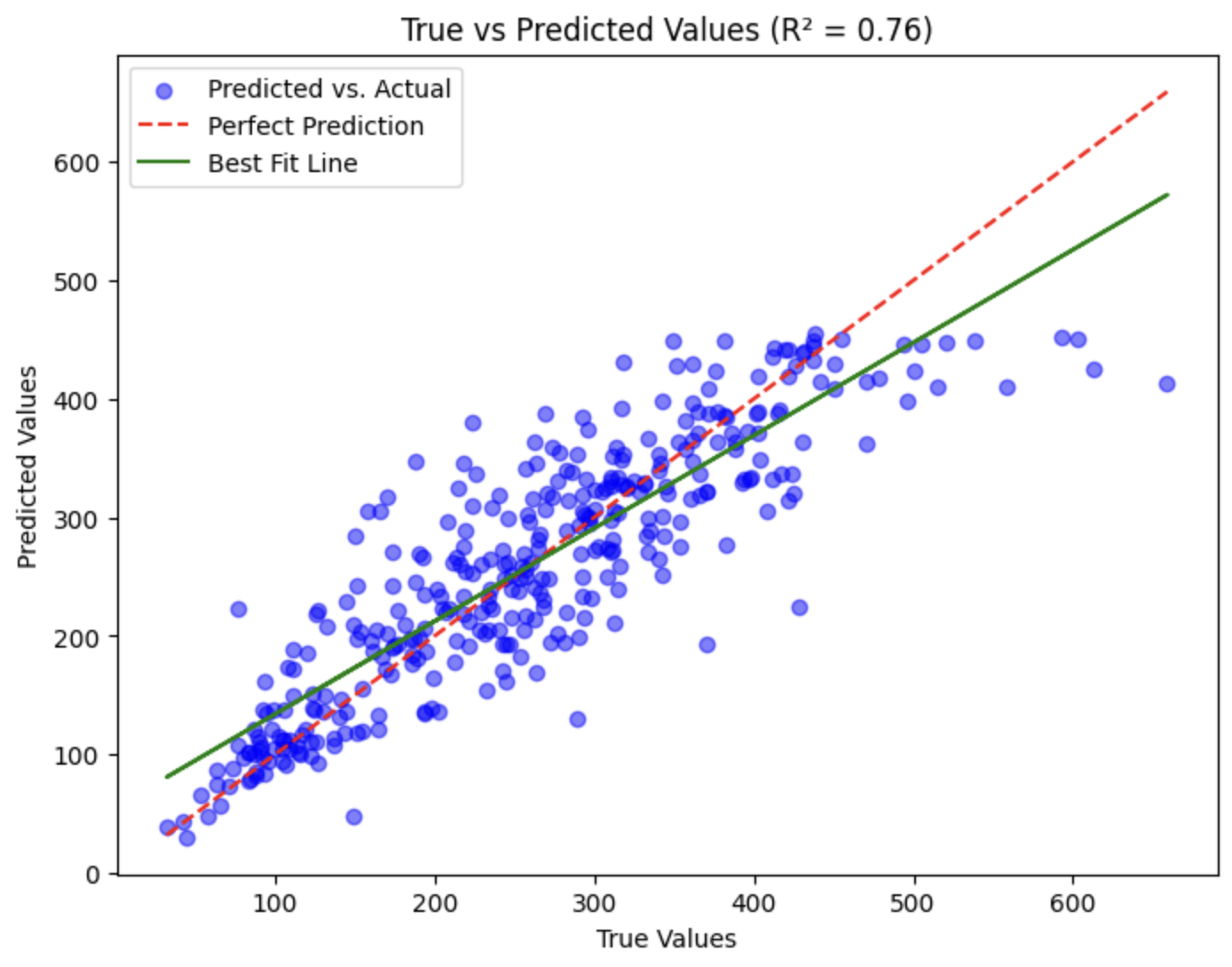
R² value
365 days:
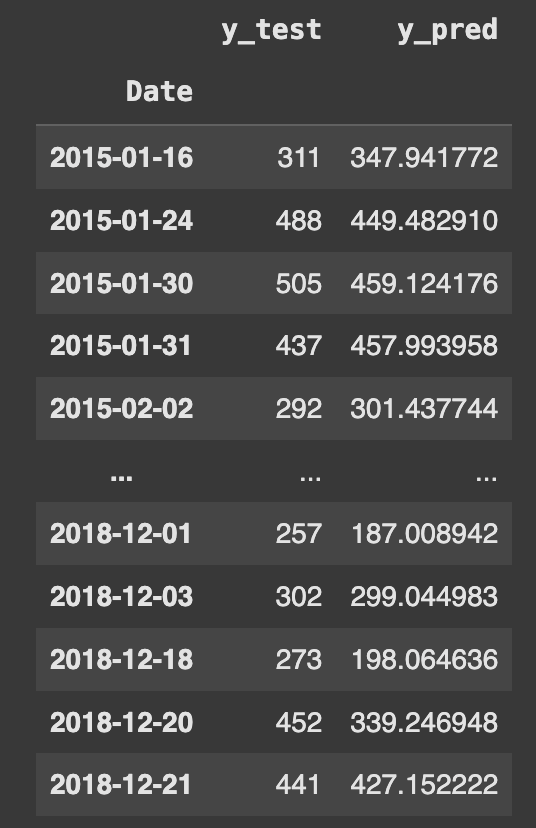
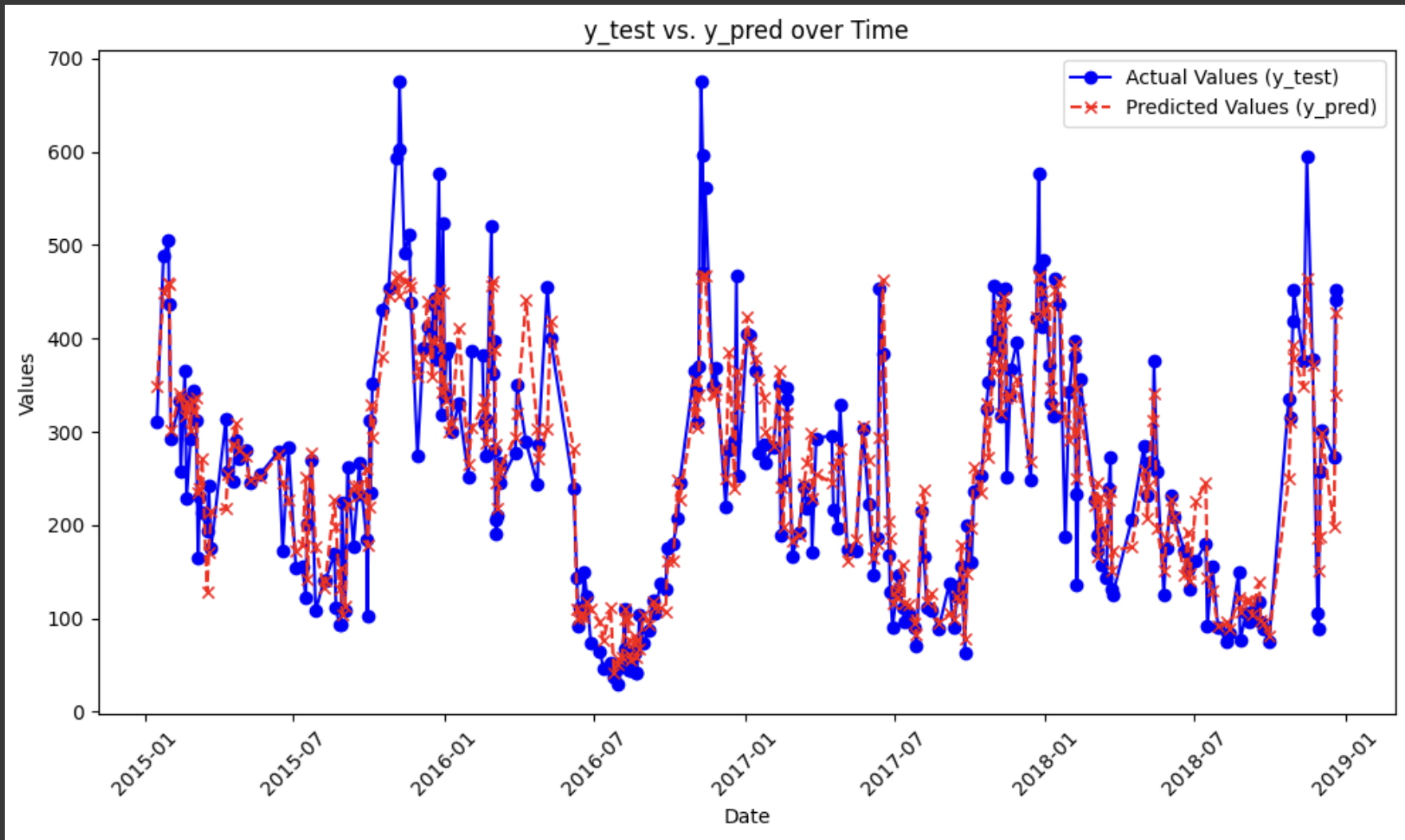
AI Prediction VS Actual Values
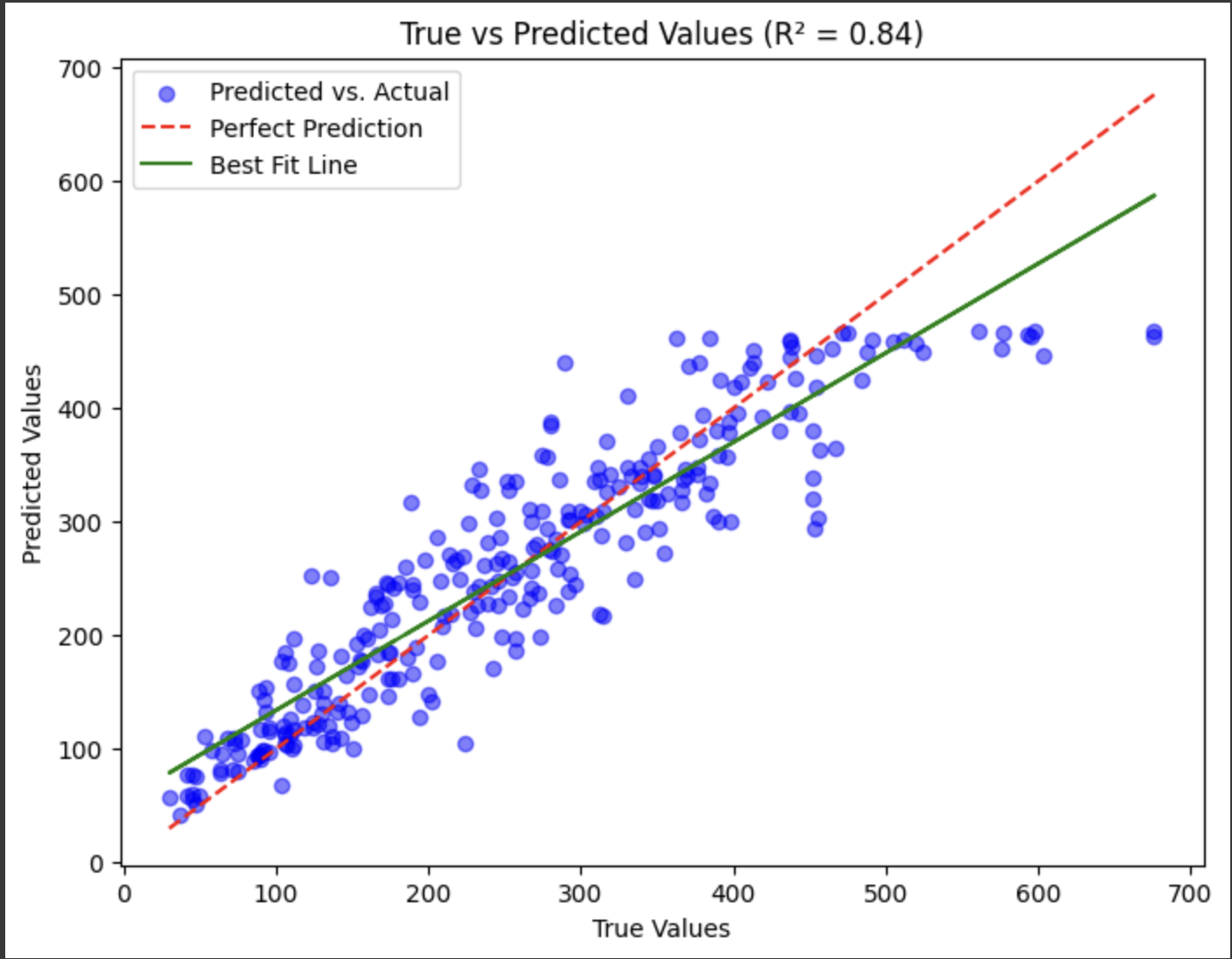
R² value
Conclusion
In conclusion, AI has proven play a vital role in aiding to predict future AQI values. As machine learning models continuously evolve and better adapt to the addition of more information, AI can form accurate predictions based on the data provided.
In the model used in this experiment, AI has proven to predict certain AQI values on a given trend. AI seems to strongly predict AQI values seven days into the future, with close predictions. Given these seven-day predictions AI can grasp onto trends like abnormally high AQI, this in turn can help with the response to wildfire or imminent emergencies that might pollute the air and endanger lives. This was proven by the Los Angeles dataset which has been impacted by extreme condition, the seven-day predictions were able to include and accurately predict high values with the given data.
While twenty-eight-day and three hundred sixty-five-day predictions were good for general AQI predictions indicating that the model has the ability to predict AQI accurately without count for cases of extreme or sudden onset air quality issues. This is evident given the results from the New York dataset where the AQI had been relatively consistent throughout the years, and the predictions tend to be more general.
AI has the ability to help us efficiently solve problems in our world. As poor air quality is a substantial threat to people around the world, the quicker we combat it the better it is for us and the environment. AI can adapt to specific needs and learn through machine-learning models to make future decisions. This can help fight issues around poor air quality for a variety of reasons from industrial pollutants in New York, to smog in China and even wildfire smoke here in Canada. AI has proven to be an effective tool for predictions and in turn help improve air quality in our environment.
Citations
About the Air Quality Health index. Alberta.ca. (n.d.). https://www.alberta.ca/about-the-air-quality-health-index
Ahmed, M. W. (2023, August 24). Understanding mean absolute error (MAE) in regression: A practical guide. Medium. https://medium.com/@m.waqar.ahmed/understanding-mean-absolute-error-mae-in-regression-a-practical-guide-26e80ebb97df
AirNow.gov, U.S. EPA. (n.d.). Aqi Basics. AQI Basics | AirNow.gov. https://www.airnow.gov/aqi/aqi-basics/
Al Jazeera. (2024, November 20). Could artificial rain fix Delhi’s toxic air pollution? https://www.aljazeera.com/news/2024/11/20/delhi-air-pollution-why-has-india-failed-to-clean-up-its-toxic-smog
Brown, S. (2021, April 21). Machine Learning, explained. MIT Sloan. https://mitsloan.mit.edu/ideas-made-to-matter/machine-learning-explained
Canada, E. and C. C. (2015, November 23). Government of Canada. Canada.ca. https://www.canada.ca/en/environment-climate-change/services/air-quality-health-index/understanding-messages.html
Canada, E. and C. C. (2016, March 22). Government of Canada. Canada.ca. https://www.canada.ca/en/environment-climate-change/services/air-quality-health-index/difference.html
Canada, E. and C. C. (2021, April 28). Government of Canada. Canada.ca. https://www.canada.ca/en/environment-climate-change/services/air-quality-health-index/about.html
Canadian Cancer Society / Société canadienne du cancer. (n.d.). Air Pollution. Canadian Cancer Society. https://cancer.ca/en/cancer-information/reduce-your-risk/know-your-environment/air-pollution
comunicación, E. de marketing y. (2024, November 18). Air pollution in New York, the challenge of Breathing Clean Air. Kunak. https://kunakair.com/air-pollution-in-new-york/
Education, U. C. for S. (n.d.-a). Center for Science Education. Effects of Air Pollution | Center for Science Education. https://scied.ucar.edu/learning-zone/air-quality/effects-air-pollution
Education, U. C. for S. (n.d.-b). Center for Science Education. What Is Air Quality? | Center for Science Education. https://scied.ucar.edu/learning-zone/air-quality/what-is-air-quality
Environmental Protection Agency. (n.d.-a). Air Quality Index Daily Values Report. EPA. https://www.epa.gov/outdoor-air-quality-data/air-quality-index-daily-values-report
Environmental Protection Agency. (n.d.-b). EPA. https://www.epa.gov/eco-research/ecosystems-and-air-quality
GeeksforGeeks. (2025a, February 27). What is LSTM - long short term memory? https://www.geeksforgeeks.org/deep-learning-introduction-to-long-short-term-memory/
GeeksforGeeks. (2025b, March 3). Mean squared error: Definition, formula, interpretation and examples. https://www.geeksforgeeks.org/mean-squared-error/
Health in cities. Health in Cities | State of Global Air. (n.d.). https://www.stateofglobalair.org/data-cities
Heinecke, R. (2024, January 16). How we calculate our air quality index and why we need it. Breeze Technologies. https://www.breeze-technologies.de/blog/what-is-an-air-quality-index-how-is-it-calculated/
How is air quality measured?. NOAA SciJinks – All About Weather. (n.d.). https://scijinks.gov/air-quality/
How is air quality measured?. UNEP. (n.d.). https://www.unep.org/news-and-stories/story/how-air-quality-measured
How’s the air quality in fire-ravaged Los Angeles? here’s what you should know. UCLA Health. (2025, January 29). https://www.uclahealth.org/news/article/hows-air-quality-fire-ravaged-los-angeles-heres-what-you
Hu, S. (2023, September 27). What is the air quality index?. Be a Force for the Future. https://www.nrdc.org/stories/what-air-quality-index
Ibm. (2024, December 19). What is a recurrent neural network (RNN)?. IBM. https://www.ibm.com/think/topics/recurrent-neural-networks
Ibm. (2025a, January 27). What is a neural network?. IBM. https://www.ibm.com/think/topics/neural-networks
Ibm. (2025b, February 14). What is an AI model?. IBM. https://www.ibm.com/think/topics/ai-model#:~:text=An%20AI%20model%20is%20a,they’ve%20been%20programmed%20for.
Ibm. (2025c, February 14). What is Artificial Intelligence (AI)?. IBM. https://www.ibm.com/think/topics/artificial-intelligence
India. Clean Air Fund. (2024, July 16). https://www.cleanairfund.org/geography/india/
Maria, C. S. (2023, May 12). Aqi, AQHI, and your health: Understanding air quality ratings. The Weather Network. https://www.theweathernetwork.com/en/news/lifestyle/health/what-is-aqi-and-aqhi-air-quality-health
Matrix background. binary code texture. falling green numbers. data... iStock. (n.d.). https://www.istockphoto.com/vector/matrix-background-binary-code-texture-falling-green-numbers-data-visualization-gm1312850689-401531597
Mean absolute error. Mean Absolute Error - an overview | ScienceDirect Topics. (n.d.). https://www.sciencedirect.com/topics/engineering/mean-absolute-error
Mean squared error (MSE). Radicalbit. (2024, July 24). https://radicalbit.ai/resources/glossary/mean-squared-error-mse/#:~:text=Data%20Scale%3A%20The%20scale%20of,in%20months%20would%20be%20undesirable.
Michael. (n.d.). Does New York City have the worst indoor air quality in the world?. Airthings. https://www.airthings.com/resources/new-york-indoor-air-quality
Mollan, C. (2024a, November 13). Delhi: India’s capital chokes as air pollution turns “severe.” BBC News. https://www.bbc.com/news/articles/c0k8dxpr8x5o
Mollan, C. (2024b, November 13). Delhi: India’s capital chokes as air pollution turns “severe.” BBC News. https://www.bbc.com/news/articles/c0k8dxpr8x5o
NASA. (2024a, May 13). What is Artificial Intelligence?. NASA. https://www.nasa.gov/what-is-artificial-intelligence/
NASA. (2024b, October 18). What is air quality?. NASA. https://www.nasa.gov/general/what-is-air-quality/
Ngo, T. (2025, January 27). Predict Air Quality with Machine Learning. Retrieved from https://www.sciencebuddies.org/science-fair-projects/project-ideas/ArtificialIntelligence_p022/artificial-intelligence/air-quality
Pollution in Los Angeles County. Rabbit Air. (n.d.). https://www.rabbitair.com/pages/pollution-in-los-angeles-county?srsltid=AfmBOopWZHTVVEfXrYbnVrSP61wmG_C61Z73lVcExPT1CPxqoUH9Gc0n
U.S. Department of Health and Human Services. (n.d.). Air pollution and your health. National Institute of Environmental Health Sciences. https://www.niehs.nih.gov/health/topics/agents/air-pollution
Vopani. (2020, July 28). Air Quality Data in India (2015 - 2020). Kaggle. https://www.kaggle.com/datasets/rohanrao/air-quality-data-in-india
What is AI model training and why is it important?. Oracle Canada. (n.d.-a). https://www.oracle.com/ca-en/artificial-intelligence/ai-model-training/
What is AI model training and why is it important?. Oracle Canada. (n.d.-b). https://www.oracle.com/ca-en/artificial-intelligence/ai-model-training/
World Health Organization. (n.d.-a). Air Pollution. World Health Organization. https://www.who.int/health-topics/air-pollution#tab=tab_2
World Health Organization. (n.d.-b). Ambient (outdoor) Air Pollution. World Health Organization. https://www.who.int/news-room/fact-sheets/detail/ambient-(outdoor)-air-quality-and-health
World Health Organization. (n.d.-c). Health impacts. World Health Organization. https://www.who.int/teams/environment-climate-change-and-health/air-quality-energy-and-health/health-impacts#:~:text=The%20specific%20disease%20outcomes%20most,(household%20air%20pollution%20only).
World Health Organization. (n.d.-d). Types of pollutants. World Health Organization. https://www.who.int/teams/environment-climate-change-and-health/air-quality-and-health/health-impacts/types-of-pollutants
World Health Organization. (n.d.-e). Wildfires. World Health Organization. https://www.who.int/health-topics/wildfires#tab=tab_1
Ηow Air Pollution Affects Our Health. European Environment Agency’s home page. (n.d.). https://www.eea.europa.eu/en/topics/in-depth/air-pollution/eow-it-affects-our-health
Acknowledgement
I would like to say thanks to every single source I used for this project, including the resources I used for my research, and the sources for my AQI values. I would also like to thank my school and CYSF for making this project possible. But most of all I would like to thank, ScienceBuddies for providing this intriguing idea and the actual model used to predict AQI values in this project. Without these resources nothing would have been possible.
Thank You!

